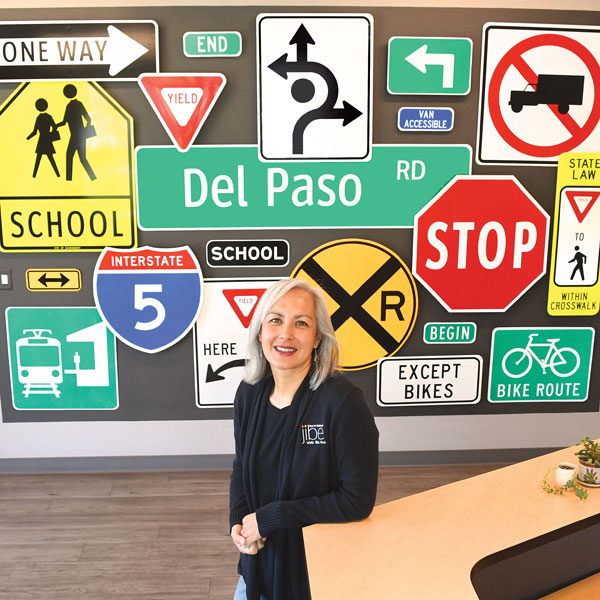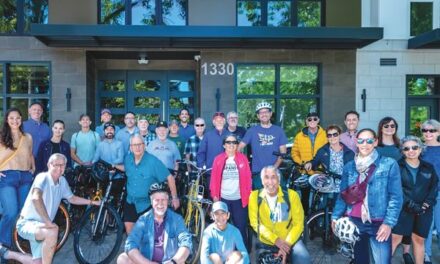California has an estimated 31 million registered motor vehicles, nearly twice as many as Texas, the next closest state. All those cars make the work of Mellissa Meng and her colleagues at North Natomas Jibe vital.
North Natomas Jibe is a nonprofit devoted to making it easier for people to walk, bike and use public transportation. Meng is executive director.

Its mission is critical. Lewis Mumford, author of such classics as “The City in History” published in 1961, laid it out when he wrote: “We have sold our urban birthright for a sorry mess of motor cars.”
“Future generations,” Mumford warned, “will perhaps wonder at our willingness, indeed our eagerness, to sacrifice the education of our children, the care of the ill and aged, the development of the arts, to say nothing of ready access to nature, for the lopsided system of mono-transportation, going through low density areas at 60 miles an hour, but reduced in high density areas to a bare six.”
Judge for yourself whether Mumford was exaggerating. But there are a lot more cars today than when he died in 1990.
There are also glimmers of hope, thanks to thoughtful urban planning and organizations like North Natomas Jibe, where Meng has worked since 2009 to entice people to leave their cars at home.
Having once ridden her bike about 900 miles from Port Angeles, Washington, to Eureka, Meng knows something about alternative transportation. She has considerable experience.
Her work is about more than reducing vehicle miles driven, the primary aim of the North Natomas Community Facilities District when it was established by the city in 1999.
Most of Jibe’s roughly $2 million annual budget comes from a modest assessment on property taxes that North Natomas businesses and residents pay, much as they do for library and other community services.
“At our core, we are trying to get people out of their cars and to provide transportation options beyond just single occupancy vehicles,” she says. “But really if you look at the core of what that is and what that provides to the community, it’s quality of life, it’s social connection, it’s sustainable communities, it’s healthier communities and it’s developing a sense of place and a sense of belonging among people who live here.”
North Natomas, far better planned than its older neighbor South Natomas, still gets a bum rap. It was designed with too many 1970s-era wide boulevards that encourage fast-moving traffic but create more congestion.
But the area also has significant numbers of parks and open spaces. Natomas Jibe helped expand the Jack Rabbit bike trail so cyclists can ride into Downtown and connect with the American River Parkway.
The need for these attractions is not relegated to Natomas or the suburbs. Livable communities consistently feature ways to get around without a car.
Midtown and East Sacramento are two of the city’s most enjoyable neighborhoods in large part because residents can walk to restaurants or meet friends for a beer or coffee.
One popular Natomas Jibe program is “Walk to School.” Students at all 10 local elementary schools get scanner cards if they want to participate.
They earn points for prizes if they walk three blocks or more to school, chaperoned by parent volunteers and paid part-time staff. The program cuts down hundreds of car trips.
“Walk to School” makes so much sense, the only drawback is that more neighborhoods don’t do something similar.
Jibe teams up with like-minded organizations such as Sacramento Area Bicycle Advocates, Slow Down Sacramento, Sacramento Bike Kitchen, Bicycling Advocates for Rancho Cordova, 50 Corridor TMA, Sacramento TMA, South Natomas Transportation Management Association and others to promote travel in something other than a car.
“This community was developed with the idea that it would be walkable, bikeable and that there would be a strong quality of life and a mixed income base,” Meng says. “It has had its struggles, but in many ways, it has achieved that and is a success story.”
Meng and her colleagues at North Natomas Jibe have a winning philosophy that every neighborhood in town should appreciate and copy.
Gary Delsohn can be reached at gdelsohn@gmail.com. Follow us on Facebook and Instagram: @insidesacramento.
















